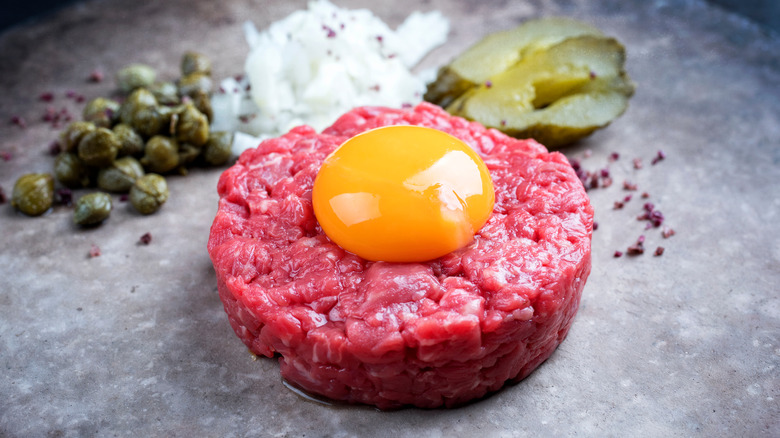The Unique History Of Steak Tartare, Once A Snack Of Warriors
Steak Tartare is one of those dishes you love and even crave — or something you would never consider eating. Many of us love all things raw in sushi but find the idea of eating raw red meat unappealing, not to mention the raw egg yolk. Like many unique recipes, Steak Tartare has a complex history. The name Tartar is used for many raw preparations. There's tuna Tartare, of course, and goat, beet, and even eel tartar. However, it's generally accepted that the original dish was made of horse meat. Regarding this unusual choice, The New York Times informs us that beef was scarce in France during the 1870 Franco-Prussian war and that horse meat was popular because it has fewer parasites.
There are two schools of thought on Tartares' origin. The most colorful tale tells of Tartars, Turkish nomads who merged with the armies of the Mongol leader Ghengis Khan in the early 13th century (via Britannica). Purportedly, the Mongol riders placed slabs of horse meat under their saddles and ate the pulverized meat raw after a long day of soldiering (per Parson's Nose). Steakhouse Maravilla suggests a more plausible theory. The dish evolved from the French Polynesian tradition of raw meat consumption combined with Georges Auguste Escoffier's revamp of the classic French tartar sauce as the dishes' condiment resulting in the version known as Steak Tartare.
Steak à l'Americaine.
According to Jewish Viennese Food, the sauce was named for the Tartar tribe, though not for obvious reasons. The French considered the Eastern European gherkin, an ingredient in the sauce, exotic, so named it after the Tartars. Another entertaining idea presented by Nino Shaye Weiss at Jewish Viennese Food pertains to steak tartare in its other incarnation, "steak à l'Americaine." Wiess proposes that because French chefs considered Americans barbarians who may not even know how to cook meat, naming the raw dish "steak the American way" was applicable. Wiess adds that by characterizing it as American, French chefs were free to use otherwise unacceptable ingredients for Haute cuisine, like Worcestershire, tabasco sauce, and, heaven forbid, ketchup.
Appropriate for its storied past, the dish also has a literary history. According to Aranjuez Steakhouse, Alexander Dumas wrote of "goat à la tartare" in the "Count of Monte Cristo," and tartar was also included in "Miguel Strogoff, The Tsar's Post Office" by Jules Vern. Fittingly, steak tartare was once on the menu at Jules Vern, the restaurant in the Eiffel Tower. The New York Times notes, Honoré de Balzac also wrote about an "eel à la tartare" in the late 1800's. If that were not enough for this dish to take its place in history, Anthony Bourdain tells us in his Cookbook: Les Halle's Strategies Recipes and Techniques that "Les Halles, the restaurant was pretty much created to serve this dish."

